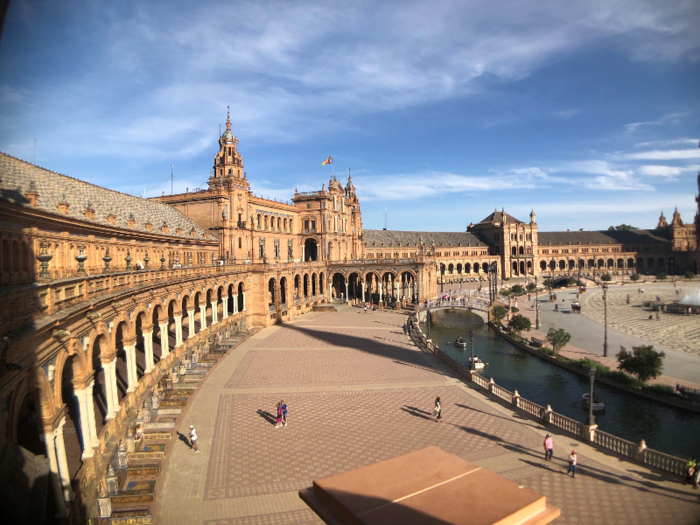
This shot of the Plaza de España in Seville was taken with the Revolver's wide-angle lens.
If you look at the top right and bottom right corners, you will see a darkening effect called vignetting. It's happening on all four corners, but the shape and shadows of the building make it harder to see. It also adds a slight overall curviness to the entire plaza, which becomes more prominent when you look at it compared to the shot below.

Here's a shot of the Plaza taken from the same spot, but with the main iPhone lens. There's no vignetting, and when you look at it compared to the previous shot, it looks like it wraps around a lot less.
This is something that happened a lot with the Revolver lens — it adds a slight circular distortion to the shots. Sometimes this makes for a really cool effect, but other times it can be pretty distracting. I like it for this, especially since the Plaza is way too big to fit in a shot taken from the regular iPhone lens.

This shot of the Alcázar of Seville has the vignetting in the top corners, there's a slight sloping effect happening across the ground, and the palm tree on the left looks like it bulges outward and then comes back in.
But I still prefer this to the iPhone shot, because it is a beautiful shot of Dorne, and the iPhone lens isn't even wide enough to fit the palm tree.

Here's the same shot, taken with the iPhone lens. There's no vignetting, the ground is flat, but the palm tree on the left barely makes it into the photo, and you don't see as much of the wall on the left.

The vignetting is especially prominent in this photo of the Itálica, which served as the Dragonpit in "Game of Thrones." The left side of the pit looks like it is either sloping upward or narrowing in, but it's actually a straight line, which you can see in the iPhone photo below.

The iPhone lens shows the pit as a straight line, but you don't see as much of the amphitheater.

This was taken at the entryway to the Chapel of Bones in Évora, Portugal. The wide-angle lens is able to capture almost the whole room with few side effects. There is some vignetting, but it is barely noticeable due to the lack of light and the corners already being pretty dark.

There isn't much difference between this shot and the one taken with the wide-angle. However, the wide-angle does show more of the chapel, which is the whole idea when you're standing in a room covered entirely with bones.

This is widely believed to be Christopher Columbus' tomb at the Seville Cathedral. There's no vignetting, but if you look below the clock at the top, it appears as though the bar bows down from the center, something you don't see in the main iPhone lens photo.

The main lens loses a lot of the surrounding detail. There's no clock, and most of the detail surrounding the tomb is missing. This makes for a good close-up shot of the tomb, but it would be nice if the iPhone could capture all the intricate details surrounding it. However, the bar above the tomb is straight, which the Revolver lens struggled with.

The remains of this Roman temple are very cool, but it would be cooler if what was left of the steps did not bubble out from the center. The vignetting here is pretty obvious, and you can really see the distortion effect on the barrier at the bottom, which should be a straight line.

This shot of the temple taken with the iPhone lens may look better (and closer to the camera), but I would prefer if it showed more of the surrounding area, and the bottom of the steps. It's disappointing that the iPhone's camera constantly cuts off surrounding scenery.

The Revolver lens is perfect for landscape shots like this, where you want to get as much of the scenery in the shot as possible. This one has the vignetting in the upper corners, which can be cropped out, but a lens that didn't do this at all would be preferable.

The iPhone's camera fills the frame with more of the sun and its surrounding glow, but leaves out the landscape and the blue sky above the sun.
 Top temples to visit in India you must visit atleast once in a lifetime
Top temples to visit in India you must visit atleast once in a lifetime
 Top 10 adventure sports across India: Where to experience them in 2024
Top 10 adventure sports across India: Where to experience them in 2024
 Market recap: Valuation of 6 of top 10 firms declines by Rs 68,417 cr; Airtel biggest laggard
Market recap: Valuation of 6 of top 10 firms declines by Rs 68,417 cr; Airtel biggest laggard

Copyright © 2024. Times Internet Limited. All rights reserved.For reprint rights. Times Syndication Service.